|
Air Traffic
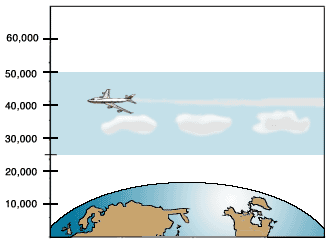
At high altitudes, the emissions of
aerosols and particulate matter influence the radiative nature of the
atmosphere which result in increased cirrus clouds and more persistent
contrails
NASA ARC Image
Contributing
to Climate Change and Ozone Destruction

1 round trip from NY to LA or Trans Atlantic round trip = 2,000 pounds of CO2
In a year air travel releases 600 million tons of carbon dioxide into the
atmosphere
By the year 2050, increased flights by jet airplanes will impact global
climate through the greater number of contrails they will produce, according
to a study completed in 1999 and published in The Journal of Geophysical
Research Letters.
A research team of
American and German scientists, headed by Patrick Minnis of the NASA Langley
Research Center in Hampton, Virginia, reports evidence that contrails cause
a warming of the Earth’s atmosphere. Currently their impact is currently
small as compared to other greenhouse effects. They predict, however, that
it may grow by a factor of six over the next 50 years. The researchers
emphasize that these are conservative estimates, which take into account
only the thicker contrails that can be readily observed.
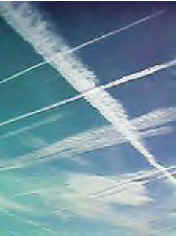
Contrails
Thinner contrails and contrails that have developed into natural-looking
cirrus clouds also affect climate, but their impact cannot yet be predicted.
Other factors that would play a role include natural cloud cover,
overlapping of contrails, and size of the ice particles that form in them.
They call for further research into the full extent of current contrail
coverage and the specific effect of contrails in forcing climate change.
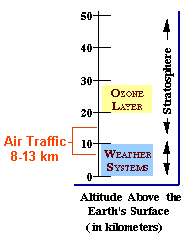
Several scientific studies have suggested that aviation may contribute to
detrimental chemical changes in the atmosphere (particularly ozone content),
as well as possible climate modification. The most widely accepted
assessments are those conducted by United Nations (U.N.) scientific
organizations. Ozone trends are monitored by the United Nations Environment
Programme (UNEP) and the World Meteorological Organization (WMO).
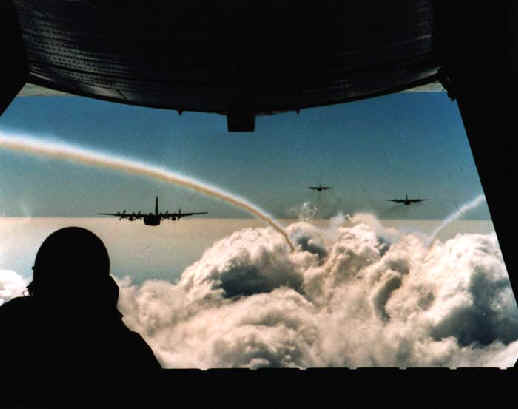
NASA Wake Vortex experiment forming of contrails
Air traffic and, therefore, contrails, are not evenly distributed around the
globe. They are concentrated over parts of the United States and Europe,
where local warming reaches up to 0.7 watts per square meter, or 35 times
the global average. The ghostly white trails following
airplanes and rockets through the sky, called contrails, are probably adding
to global warming, according to scientists at NASA’s Langley Research
Center, Hampton, Va. The contrails often turn into cirrus clouds, a thin,
wispy type of cloud made of ice crystals. The most common form of high-level
clouds are thin and often wispy cirrus clouds. Typically found at heights
greater than 20,000 feet (6,000 meters), cirrus clouds are composed of ice
crystals that originate from the freezing of super cooled water droplets.
Cirrus generally occur in fair weather and point in the direction of air
movement at their elevation. While some clouds tend to help cool the globe
and negate the affects of global warming, thin cirrus clouds are heat
trappers, holding in more heat than they reflect back into space.
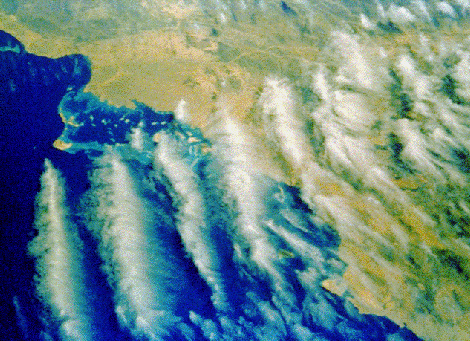
NASA Space Shuttle view from
space of cirrus clouds over Saudi Arabia
Contrails are human-induced clouds that only form at very high altitudes
(usually above 8 km) where the air is extremely cold (less than -40°C). If
the air is very dry, they do not form behind the plane. If the air is
somewhat moist, a contrail will form immediately behind the aircraft and
make a bright white line that lasts for a short while. Persistent contrails
form immediately behind the airplane in very moist air. Persistent
contrails can exist long after the airplane that made them has left the
area. They can last for a few minutes or longer than a day. However, because
they form at high altitudes where the winds are usually very strong, they
will move away from the area where they were born. Persistent
contrails are those most likely to affect climate.
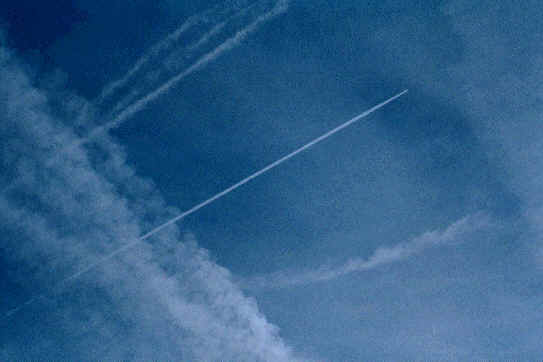
Present commercial aircraft fly at altitudes of 8-13 km. The emissions from
such air traffic can change the atmospheric composition: Directly: by
emitting carbon dioxide (CO2), nitrogen oxides (NOx = NO + NO2), water
vapor, hydrocarbons, soot, and sulfate particles. Indirectly: by a
chemical reaction chain similar to smog-formation the greenhouse gas ozone
(O3) can be formed. In this reaction chain nitrogen oxides act as a catalyst
under the influence of sunlight. As a result of these chemical reactions
also the concentration of methane (CH4), another greenhouse gas, decreases.
These changes can have effects on climate: Ozone, CO2, and water vapor are
greenhouse gases and their increase has a warming effect. Methane is also a
greenhouse gas and its decrease has a cooling effect. Aerosols (sulfate
particles, soot) could have a cooling effect. Contrails formed due to the
emission of particles and water vapor can increase the cloud cover in the
upper troposphere. This may result in a cooling or heating depending on the
size and optical depth of the ice crystals of which the contrails consist.
Presently it is believed that contrails lead to a net warming effect. There
may be changes in (non-contrail) upper level clouds: Most contrails decay
after minutes to hours, but some continue to exist and are then not
distinguishable from natural cirrus clouds .
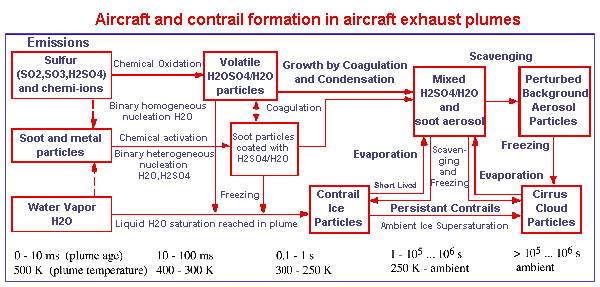
Schematic based on DLR German Aerospace Center graphic and text
Schematic of aerosol and contrail formation processes in an aircraft plume and
wake as a function of plume age and temperature. Reactive sulfur gases, water
vapor, chemi-ions, soot aerosols, and metal particles are emitted from the
nozzle exit planes at high temperatures. H2SO4 increases as a result of
gas-phase oxidation processes. Soot particles become chemically activated by
adsorption and binary heterogeneous nucleation of SO3 and H2SO4 in the presence
of H2O, leading to the formation of a partial liquid H2SO4/H2O coating. Upon
further cooling, volatile liquid H2SO4/H2O droplets are formed by binary
homogeneous nucleation, whereby the chemi-ions act as preferred nucleation
centers. These aerosols grow in size by condensation and coagulation processes.
Coagulation between volatile particles and soot enhances the coating and forms a
mixed H2SO4/H2O-soot aerosol, which is eventually scavenged by background
aerosol particles at longer times. If liquid H2O saturation is reached in the
plume, a contrail forms. Ice particles are created in the contrail mainly by
freezing of exhaust aerosols. Scavenging of exhaust particles and further
deposition of H2O leads to an increase of the ice mass. The contrail persists in
ice-supersaturated air and may develop into a cirrus cloud. Short-lived and
persistent contrails return residual particles into the atmosphere upon
evaporation. The scavenging timescales are highly variable and depend on the
exhaust and background aerosol size distributions and abundances, as well as on
wake mixing rates
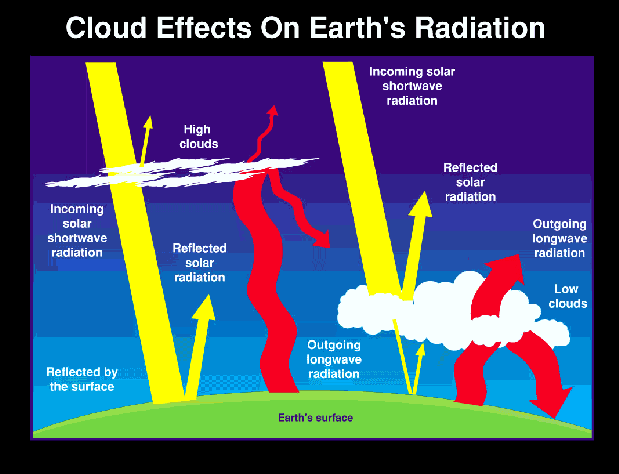
NASA Graphic from The TERRA Program
Clouds play a complex role in the Earth's radiation budget. Low Clouds
reflect much of the sunlight that falls on them, but have little Effect on
the emitted energy. Thus, low clouds act to cool the Current climate. High
clouds reflect less energy, but trap more of The energy emitted by the
surface.
The Atmospheric Effects of Aviation Project
For the past 10 years NASA has held a conference on The Atmospheric
Effects of Aviation Project (AEAP). Several hundred researchers from
around the world attend annually. In 1997 Researchers from NASA Langley
Research Center in Hampton, Virginia, presented evidence that contrails
are contributing to global warming and causing local effects over areas
with heavy air traffic. This was reported by Jim Scanlon a journalist in
attendance at the conference. He also reports that Fred Singer held a
session where he presented a session that argued that the steady increase
in air traffic for the last 20 years was responsible for the nighttime
warming detected over North America.
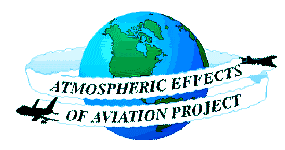
NASA
The Atmospheric Effects of
Aviation Project (AEAP) consists of two major efforts to assess the effect
of aircraft on the atmosphere. The Atmospheric Effects of Stratospheric
Aircraft (AESA), sponsored by the High-Speed Research (HSR) Program at
Langley Research Center, is a study of the potential effects of the
operation of a projected future fleet of high speed civil transport aircraft
(HSCTs). The Subsonic Assessment program (SASS) is a study of the effects of
the present subsonic aircraft fleet and of projected future subsonic fleets,
and is sponsored by the Advanced Subsonics Technology Program (AST) at
Langley Research Center. Objective Develop scientific basis for assessment
of atmospheric impact of subsonic and supersonic aviation, particularly
commercial aircraft cruise emissions.
Chemtrails or Contrails: Conspiracy or Simple Science?
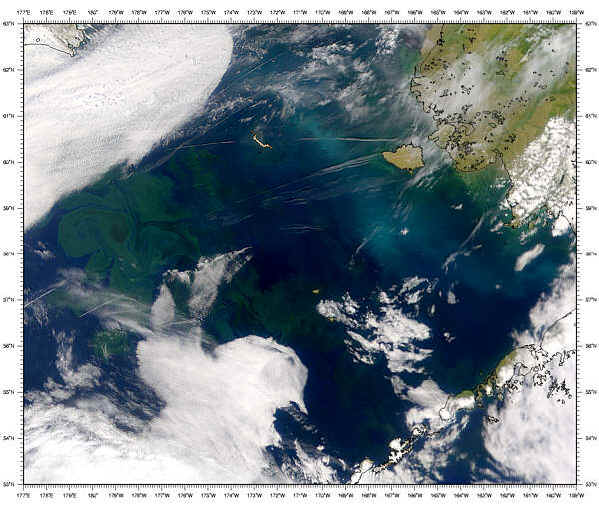
Contrails over Bering Sea
Sea
WiFS Project, NASA/Goddard Space Flight Center, and
ORBIMAGE Satellite: OrbView-2 Sensor: SeaWiFS
The conspiracy theory is that government officials are conducting
experiments in atmospheric science, and some of them involve a highly classified
military project which involves protecting us from some as yet unknown threat.
The side effects of people getting sick is part of the price we pay for defense
is what the "conspiracy obsessed people" think.
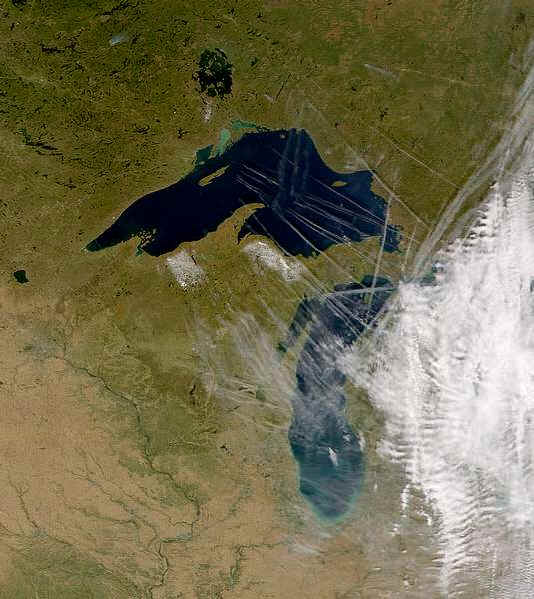
Contrails Over Lake Superior
SeaWiFS Project, NASA/Goddard Space Flight Center, and ORBIMAGE Satellite:
OrbView-2 Sensor: SeaWiFS
People worldwide are reporting what they describe to be unusual activity
in the sky, including jets leaving trails at low altitudes, spray lines
creating X's, S's and parallel lines, lines that slowly spread to create
a canopy of haze, and reports of unusual smells, tastes, and even
illness related to the trails.
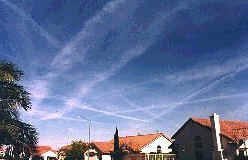
This conspiracy theory has been sweeping the Internet and radio talk
shows has set parts of the federal government on edge. The US Government
has received thousands of phone calls, e-mails and letters in recent
years from people demanding to know what's being sprayed and why.
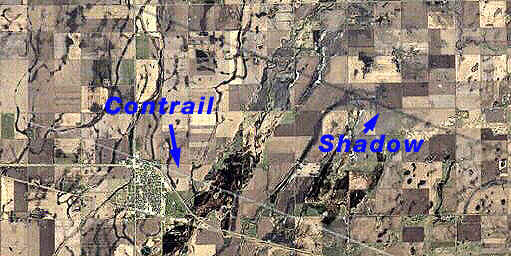
The Environmental Protection Agency, NASA, the Federal Aviation
Administration and the National Oceanic and Atmospheric
Administration published a fact sheet explaining the science of contrail
formation.
https://www.epa.gov/otaq/regs/nonroad/aviation/contrails.pdf
A few months earlier, the Air Force had put out its own fact sheet,
which tries to refute its opponents' arguments point by point. "If you
try to pin these people down and refute things, it's, 'Well, you're just
part of the conspiracy,' " says atmospheric scientist Patrick Minnis of
NASA's Langley Research Center in Hampton, Va. "Logic is not exactly a
real selling point for most of them."
U.S. Air Force Report
The "Chemtrail" Hoax
A hoax that has been around since 1996 accuses the Air Force of being
involved in spraying the US population with mysterious substances and
show various Air Force aircraft "releasing sprays" or generating unusual
contrail patterns. Several authors cite an Air University research paper
titled "Weather as a Force Multiplier: Owning the Weather in 2025"
(http://www.au.af.mil/au/database/research/ay1996/acsc/96-025ag.htm)
that suggests the Air Force is conducting weather modification
experiments. The purpose of that paper was part of a thesis to outline a
strategy for the use of a future weather modification system to achieve
military objectives and it does not reflect current military policy,
practice, or capability.
The Air Force's policy is to observe and forecast the weather. The Air
Force is focused on observing and forecasting the weather so the
information can be used to support military operations. The Air Force is
not conducting any weather modification experiments or programs and has
no plans to do so in the future.
The "Chemtrail" hoax has been investigated and refuted by many
established and accredited universities, scientific organizations, and
major media publications.
Claims and Facts
Claim: Long-lasting contrails are something new and they have abnormal
characteristics.
Fact: Contrails can remain visible for very long periods of time with
the lifetime a function of the temperature, humidity, winds, and
aircraft exhaust characteristics. Contrails can form many shapes as they
are dispersed by horizontal and vertical wind shear. Sunlight refracted
or reflected from contrails can produce vibrant and eye-catching colors
and patterns. Observation and scientific analysis of contrails and their
duration date back to at least 1953.
Claim: Grid patterns of contrails in the sky are evidence of a
systematic spraying operation.
Fact: The National Airspace System of the United States is orientated in
an east-west and north-south grid with aircraft flying at designated
2000 foot increments of elevation. Contrails formed by aircraft may
appear to form a grid as the winds disperse the contrails. More
contrails are seen in recent years due to the growth in the civil
aviation market. The FAA is responsible for the NAS and Air Force
aircraft operate under the same rules and procedures as civilian
aircraft when using the NAS.
Claim: There are reported outbreaks of illness after the appearance of
"Chemtrails"
Fact: There is no such thing as a "Chemtrail". Contrails are safe and
are a natural phenomenon. They pose no health hazard of any kind. If
there are massive outbreaks of illnesses, your local health department
should be able to tell you if it is an abnormal event. Local health
departments generally network together when they start seeing problems.
If there is a problem, the CDC will get involved.
Claim: Samples taken have shown the presence of the "DOD patented"
bacteria pseudomonas fluorescens.
Fact: The bacteria claimed to be DOD developed and patented is actually
a common, naturally occurring bacteria. The U.S. Patent Office
(www.uspto.gov) lists 181 patents involving pseudomonas fluorescens,
none of which are held by DOD.
|